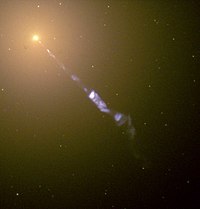
Photo from wikipedia
In this work, we investigate numerically the temporal evolution of Turbulent Kinetic Energy (TKE) of a chemically-reacting n-heptane and air mixture in statistically Homogeneous Isotropic Turbulence (HIT). Our specific focus… Click to show full abstract
In this work, we investigate numerically the temporal evolution of Turbulent Kinetic Energy (TKE) of a chemically-reacting n-heptane and air mixture in statistically Homogeneous Isotropic Turbulence (HIT). Our specific focus is on the concurrent view of TKE evolution in both physical and scale (Fourier) spaces to identify the impact of reaction-induced heat release on turbulence. The simulation parameters are selected to represent the combustion characteristics of heavy hydrocarbon fuels under engine conditions. Results indicate that pressure dilatation work dominates the TKE evolution during the period of strong heat release and its dominance is attributed to the strong volumetric dilatation associated with the presence of reaction fronts in physical space. Viscous dissipation and viscous dilatation terms become much stronger with increasing heat release, primarily due to the increase in strain-rate and dilatation at the vicinity of the reaction fronts, but their magnitudes are still small compared to that of pressure dilatation work. In addition, the analysis in Fourier space shows that pressure dilatation work dominates the evolution of TKE not only in the mean, but also over a wide range of scales. The spectrum of pressure dilatation shows a power-law behavior, which is a direct consequence of the localized sheet-like reaction fronts in physical space. It is also shown that viscous dissipation spectrum initially removes kinetic energy at small scales when heat release is weak, but starts to remove kinetic energy at intermediate and later at large scales due to the presence of localized reaction fronts during the strong heat release period. More interestingly, it is observed that the inter-scale kinetic energy transfer spectrum moves energy from less dissipative scales (small scales) to scales where kinetic energy is more effectively removed by viscous dissipation work (large scales) during the period of strong heat release, which indicates possible up-scale kinetic energy transfer in Fourier space.
Journal Title: Flow, Turbulence and Combustion
Year Published: 2018
Link to full text (if available)
Share on Social Media: Sign Up to like & get
recommendations!